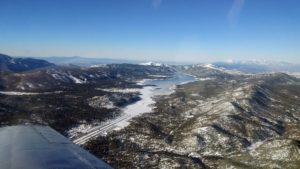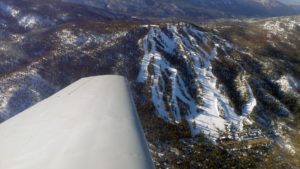Ah, finally coming down to the end of the insurance transition requirements. I’m feeling pretty good in the plane, although I still have quite a way to go in learning how long it takes to slow her down. The Mooney really isn’t that different to fly than the Cherokees that I trained in, it’s just faster, so everything happens faster. That, and it doesn’t like to slow down. With the Cherokee you could pull the throttle and push it over into a dive and really didn’t pick up much speed. In the Mooney you can pull the throttle and push it over into a shallow descent and just watch the speed build up. As a result, I have a tendency to slow down too early when approaching the pattern at an airport because I am worried that if I don’t then I won’t be able to slow down in time.
It was windy this morning but at least the winds were fairly steady, unlike yesterday when it was gusty. I decided for my last couple of hours I would fly up around Big Bear to see the lake and mountains with all their snow. One of the guys over on the Mooneyspace forums calls it “Flightseeing” when you’re flying around just looking out the window, and I think it describes the flight perfectly.
It was bumpy leaving Corona as I began my climb to the north-east, but once I got past about 6,000′ it smoothed out. I am still amazed at how “close” places are when you are flying instead of driving. Before I knew it I was looking at the west end of the lake and marveling to myself that I was already there. I flew along the north shore of the lake and then turned south after passing the airport to head west along the ridge where the ski resorts are. It was beautiful with all the snow and seeing the lake partially frozen over.
I thought about heading back, but I had time to burn so I flew over to Lake Arrowhead before turning south-west. Once I cleared the mountains I began a shallow descent and was seeing ground-speeds that occasionally nudged above 200 mph. I read someone say that in a Mooney you can slow down, or you can descend, but you can’t do both at the same time without speed-brakes (and I don’t have any speed-breaks). I only had about 30 miles from the ridge-line to the airport, but I really needed at least 50 miles for the descent, so I made a couple turns around Lake Matthews to bleed off some speed and altitude.
With time left to burn, I dialed up the ATIS for Chino, made a note of the information, and called up the tower. The winds were reported as calm and they were using runways 26L and 26R.
Me: “Chino Tower, Mooney 78-878 (with a little pause between the first and second 8 in the tail number, it seems to help them get the number right) 2,500 over the 91 15 interchange, inbound for a full stop taxi back with information Uniform.”
Tower: “Mooney 78878, enter left base for runway 26L.”
Me: “Enter left base for 26L, 878.”
Here is where it got interesting. A left base is at 90° to the runway. If I am landing on 26L, the left base would be flown at a heading of 350°. You rarely are flying the direct heading because the winds will force you to “crab” (fly at an angle to the heading you want) into the wind so that you have a straight track in relation to the ground. Because you always want to land into the wind, on the base leg you are typically crabbing towards the airport. However, I was flying along at about 1,600′ and crabbing away from the airport at a heading of about 20° which is about a 30° crab angle… I’m thinking to myself “Is the ATIS information old and hasn’t updated? Am I going to be coming in with a tailwind?” Just then another plane called the tower and when the tower answered they also gave updated winds, 330 at 3 knots. Here I am about 1,100′ above the airport elevation being pushed by a wind coming from a heading of about 90-110° and the winds just a few miles west of me on the ground are coming from a heading of 330°…
Tower: “Mooney 78878, runway 26L, cleared to land.”
Me: “26L cleared to land, 878.”
I began my turn to final and as I descended the plane was all over the place. It felt like driving a rear wheel drive car on a snowy/icy road with the back of the plane fishtailing back and forth. I had my eye on the ball in the turn coordinator and was dancing on the rudder pedals to try and keep it centered and get stabilized. In my mind I was preparing to abort and go around but once I got down to about 500′ AGL (Above Ground Level) it all smoothed out, what a relief. I was able to set the plane down and exit the runway.
I received my taxi instructions and made my way back to the end of 26L, then went through my pre-takeoff checklist and got everything set. After a short delay I was given clearance to take-off along with an advisory to watch out for the flock of birds that was making its way across the runways.
The tower had asked me where I was headed prior to departing and I told him Corona. I picked up the conditions at Corona from the AWOS shortly after getting airborne at Chino and shortly after that the tower gave me the frequency change. I made the switch and started making my position calls on the CTAF (Common Traffic Advisory Frequency). The reported winds were going to give me a 10 knot crosswind for runway 7. I wasn’t very excited about that… but thought that I would just get lined up and if I could hold the center-line I would land it, if not I would go around until I could. I had plenty of fuel so eventually I would be able to land…
The day before a friend and I had watched a couple of planes landing on 7. As they would come in over the trees on final you could see them getting bounced around and watch the pilot making corrections to stay lined up. The combination of the wind with the buildings and trees makes for some exciting mechanical turbulence. It was no different for me today.
Coming down final approach I would have my nose lined up, and then it wouldn’t be. I would drift a little left, then a little right, and the whole time the airspeed indicator was bouncing up and down +/- 5-10 mph. The wind was not the reported steady speed, it was gusting. The runway at Corona is 60′ wide, which is plenty of space to land a Mooney. The main landing gear on the Mooney is under 10′ wide, so in reality you only need about a 20′ wide runway if you can keep it centered. The problem I was having as I came down final was I wasn’t sure which 20′ of the runway I would be using, the middle section, the section on the right, or the section on the left. It turned out to be the section to the left of the center-line.
I came in with only one pump on the flaps, not even the two pumps for take off setting. Less flaps means a higher approach speed which is good when dealing with a gusty cross-wind. I set it down hard enough that I thought it was going to bounce, but the plane stuck to the runway and I rolled out about half-way down before exiting. It was an exciting finish to my last required solo hours. The next flight will be with passengers.


